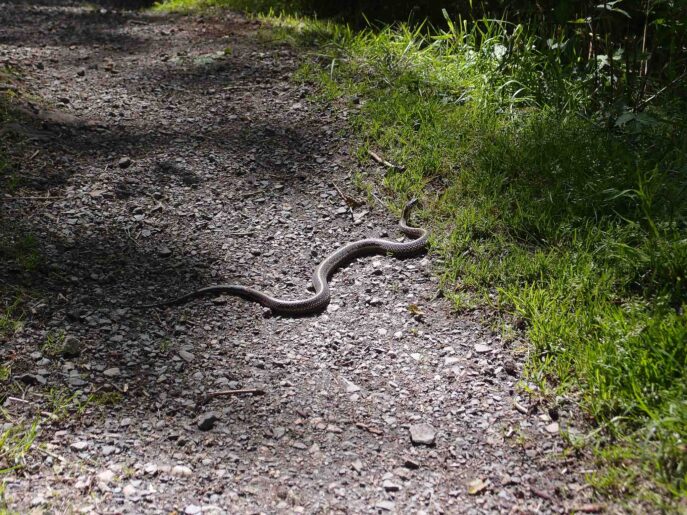21 Best Things to Do in Shawnee National Forest
Shawnee National Forest is a vast park that covers about 451 square miles of southern Illinois.
Shawnee National Forest is a stunning area with rolling hills, rocky bluffs, oak-hickory forests, lush canyons, thriving marshes, and unique landscapes around every bend.
Of the endless things to do in Shawnee National Forest, visitors will find incredible hiking trails, swimming holes, biking paths, unparallel bird/animal watching, camping, horseback riding, kayaking/canoeing, rock climbing, and much more.
Drawing around 1 million visitors every year, Shawnee National Forest is an incredible nature retreat and has something for everyone to enjoy.
This post may contain affiliate links. If you click one of them, we may receive a small commission (for which we are very grateful for) at no extra cost to you. Thank you for the support!
How to Use This Guide
Because Shawnee is such a huge area, it can make it can be a bit difficult to try and plan your trip and decide what area you would like to see.
We find when we visit Shawnee National Forest, we like to break our trip into different areas. That way we don’t waste too much time driving and we can spend more time enjoying ourselves.
To help you plan your trip we’ve broken the things to do section down into three areas of the park:
- Things to do near Garden of the Gods
- Things to do near Little Grand Canyon
- Things to do near the Ohio River
Now you’ll be able to spend more time hiking exploring all the bes things to do in Shawnee National Forest and less time driving back and forth!
SHAWNEE NATIONAL FOREST QUICK GUIDE
Don’t have much time? Here are the top takeaways from this article to help you plan your trip:
- Best place to stay: This adorable cabin is centrally located, has raving reviews, and is clean, modern and comfy.
- Best Hike: This easy 1.2-mile hike in Bell Smith Springs Recreation Area has it all; gorgeous rock formations, swimming holes, and a natural bridge.
- Best Thing to do: Visit the Garden of the Gods Recreation area
Here are some more resources to our other articles about Shawnee National Forest to help you plan your trip:
Shawnee National Forest Map
Things to Do Near Garden of the Gods
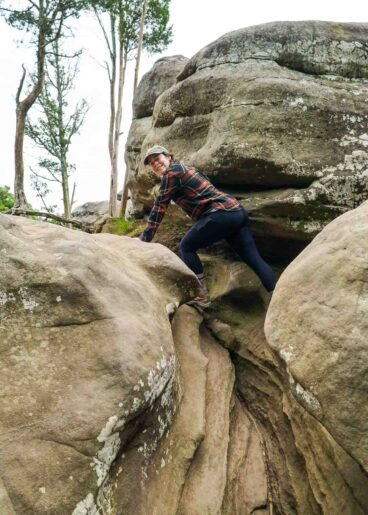
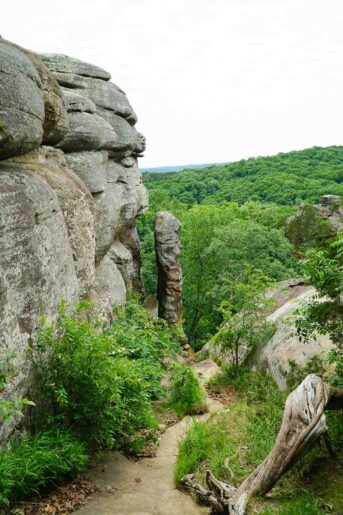
1. Garden Of The Gods Recreation Area
If you only have time to do one thing in Shawnee National Forest, visit the Garden of the Gods Recreation Area. It’s a stunning combination of rocky bluffs, heavenly forest areas, and scenic overlooks where you can take it all in.
There are hiking trails ranging from less than a mile to over 14 miles. Picnic areas, rocks to climb on, rock formations that look like animals and so much more.
It’s a particularly great place to stop if you have kids because there are a ton of things for them to see and interact with.
Google Maps: Garden of the Gods Recreation Area
2. Hike at Rim Rock National Recreation Area
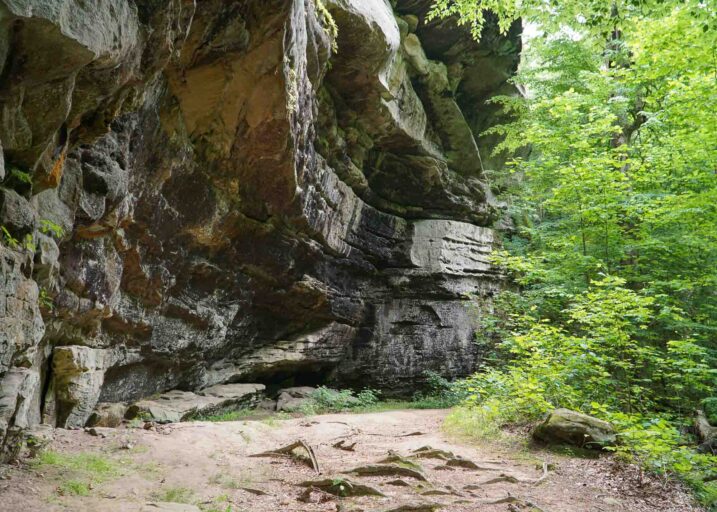
Just east of Garden of the Gods on Karbers Ridge Rd is another one of the best spots in Shawnee National Forest, Rim Rock National Recreation Area. There is an upper as well as a lower hiking trail. The upper trail will take you around the rim of a large rocky bluff (hence the name “Rim Rock”).
You’ll pass some ruins from an ancient stone wall that was built by Native Americans as well as some of the most beautiful overlooks around! The Upper Rim Rock Trail is also one of only a few National Recreation Trails in Illinois.
AllTrails: Rim Rock Trail
The lower trail will take you around the base of the outcropping and bring you right past Ox-lot cave. Ox-lot cave is a historical site where pioneers in the area would keep their animals so they were sheltered from the weather.
Both are great hikes and Rim Rock is often far less crowded than Garden of the Gods. It’s a great option if you’re visiting on a popular weekend and looking to get away from some of the crowds.
Google Maps: Rim Rock National Recreation Area
3. Visit Bell Smith Springs

We could spend days exploring Bell Smith Springs, it’s one of our favorite places to hike & explore.
Make sure you check out our full article on planning a trip to Bell Smith Springs. There are over 8 miles of hiking trails in this area as well as cliff jumping, swimming holes, historical stone steps and so much more!
Bell Smith Springs is also home to the largest natural bridge in Shawnee National Forest. It’s 125 feet long and over 30 feet high! You can find it on the yellow trail which is about a mile and a half if you hike the entire trail.
Bell Smith Springs also has a campground (Redbud Campground) which is super convenient if you’re looking for an area where you can explore and camp without needing to travel around too much.
Google Maps: Bell Smith Springs Parking Lot
4. Hike To Waterfalls
Shawnee National Forest has several really great waterfalls. Most of them are weather dependent so if it hasn’t been raining recently there’s a chance there may not be any water flowing.
But we highly recommend making a stop at both Burden Falls and Jackson Falls. Both of them have water flowing pretty regularly.
Burden Falls is very close to Bell Smith Springs, so if you’re going to be doing any Shawnee National Forest camping at the Redbud campground it’s only about 10 minutes down the road!
Jackson Falls is also relatively close and if you plan on doing any rock climbing in Shawnee then Jackson Falls is the perfect spot.
Be sure to read our full article on visiting Jackson Falls for more information about camping, hiking & climbing in the area.
Google Maps: Burden Falls and Jackson Falls
5. Selfie With Sasquatch
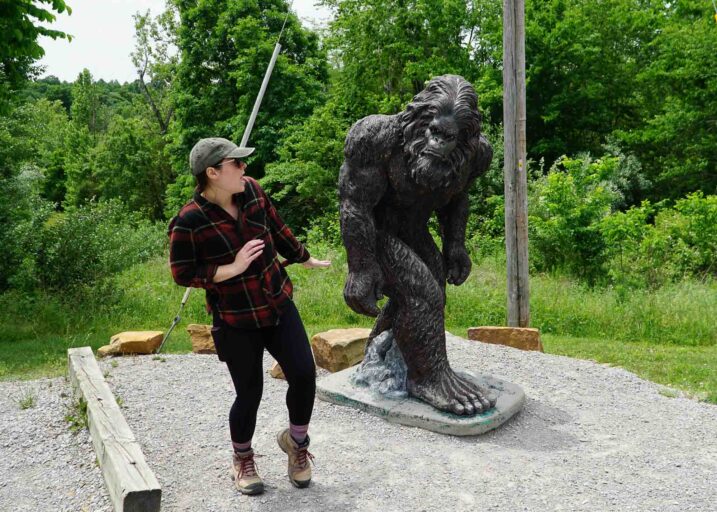
This one is almost too silly not to include and is one of the quirkiest Shawnee National Forest attractions!
Don’t make a special trip for it, but if you’re going to visit either Garden of the Gods or Rim Rock then you’re going to drive right past this big Sasquatch statue. Every year hundreds of people pull over to take a selfie with him.
If you have some young kids in the car or even just a friend who’s getting a little impatient it can be the perfect spot to stop and do something fun for a few minutes.
So if you’re looking for a great quick little stop, you’ll find Sasquatch hanging out at the corner of Karber’s Ridge Rd and Garden of the Gods Rd.
Google Maps: Sasquatch Statue
6. Enjoy Some Ice Cream
If you did decide to stop and take a quick selfie with Sasquatch then right across the road is a really great little ice cream shop! It’s called the Garden of the Gods Outpost and they not only have ice cream but lots of other little things as well.
Most of the area around Garden of the Gods is pretty rural and so you won’t find a ton of shops to buy little things that you may have forgotten to pack.
If you need firewood or some more bug spray it’s the perfect place to stop and grab some before heading on to Garden of the Gods or back to your campsite.
Google Maps: Garden of the Gods Outpost
7. Paddle Around Pounds Lake

The Pounds Hollow Recreation Area is the perfect spot whether you’re planning on camping in Shawnee National forest or you just want to hang out by the water for a little while.
Pounds Hollow has the Pine Ridge campground which is one of our favorite places to camp. It’s super close to Garden of the Gods which is only about 15 minutes down the road.
But you could easily spend the entire day not going anywhere at all! Pounds Lake is behind the campground making it only a short walk away from your campsite.
There’s a beach, lots of picnic space, and even a large pavilion. The lake is usually really calm and surrounded by a beautiful dense forested area making it the perfect place to either go swimming or paddle around in a kayak.
Google Maps: Pounds Lake Parking Lot
8. Go Rock Climbing
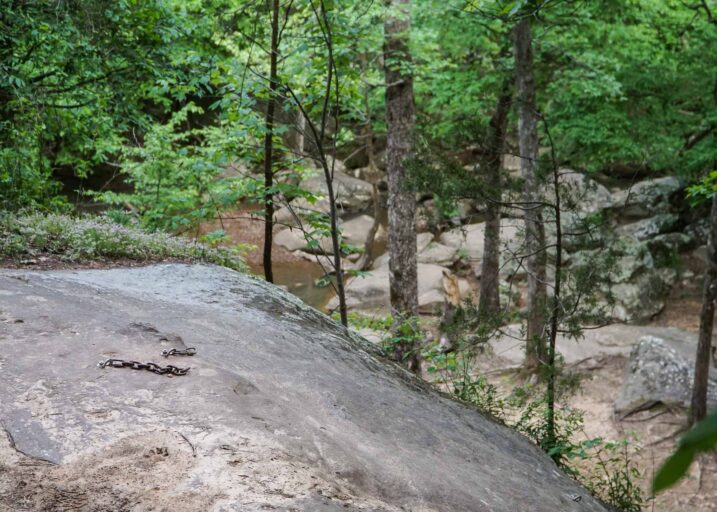
One of the biggest draws to Shawnee National Forest Illinois is the combination of rocky boulders and thick forest. It not only creates some beautiful vistas but it’s also great for rock climbing!
While there are several places around southern Illinois for rock climbing, Jackson Falls is the only officially designated place for rock climbing that is actually within Shawnee National Forest.
There are anchor points already set all around the top of the waterfall and so if you have your own equipment and are an experienced climber then you’ll definitely want to add it to your list of places to visit in Shawnee!
You can check out our full article on visiting Jackson Falls for more information about climbing in the area.
9. Rent a Cabin or a Treehouse
There are some great options for some incredible treehouses and cabins in Shawnee National Forest. We are regular visitors to Shawnee National Forest, and each time we choose to stay somewhere different.
Cabins and treehouses make for the perfect short break for romantic couples, as well as being a great option for families with young kids! We’ve stayed in cabins in the Shawnee area ranging from traditional to modern, some deep in the forest and some with stunning lakeside views.
10. Climb Trigg Tower
Trigg Tower is a perfect stop if you’re on your way to Bell Smith Springs or Jackson Falls. It was originally built as a watch tower for fires and while it’s no longer officially in service it’s still one of the best places to get up above the trees and see the surrounding area.
It’s a quick stop, there’s no trail, just a parking lot at the base of the tower. But if you’re not afraid of heights and want to get a better sense of the area then it’s well worth the quick stop!
Google Maps: Trigg Tower
11. Millstone Bluff Archaeological Area
South of Jackson Falls is the Millstone Bluff Archaeological area which is definitely one of the must-see spots in Shawnee National Forest if you would like to experience more of the history of the area.
Millstone Bluff was home to the Mississippian people for almost 200 years and you can still see some of the remains from their homes as well as the walls that they built around the bluff.
There is a short family-friendly one-mile hiking trail and even some petroglyphs to check out!
The Mississippian people carved all sorts of images on the walls including everything from falcons to geometric shapes.
Google Maps: Millstone Bluff
Things to Do Near Little Grand Canyon
12. Little Grand Canyon
This is a great spot to visit, especially during April and October. We’re big fans of the spring wildflowers as well as the fall colors. The Little Grand Canyon is home to one of the most popular Shawnee National Forest hiking trails.
Although the trail isn’t particularly long, it’s just shy of 3 miles, it will probably take about 3-4 hours to complete. There are a lot of things you’ll want to stop to look at.
The upper part of the trail features some great lookout points from the 300-foot bluffs. It then leads through a scenic route through the canyon on rocky terrain with the bottomland forests of oak and hickory.
This is a great trail for families, as the upper part is a gravel path. Just be aware of the steep drops on either side of the trail in places. The trail does offer some great views so long as you don’t mind the heights.
A small side path leads off from the main graveled trail, on a clear day you can see both the Mississippi and Big Muddy rivers to the far western horizon. It’s also worth hiking this trail to see the sunset views over the valley.
13. Oakwood Bottoms
If you’re a fan of waterfowl and bird watching then be sure to visit Oakwood Bottoms. Oakwood Bottoms is also a great spot for other activities like picnics and a stroll on the wooden boardwalk.
There is a large picnic shelter next to a pond which is a great spot to see some wildlife including ducks and other birds that visit the pond in search of food.
Nearby you’ll also find the Big Muddy Boat Launch where you can launch your boat or kayak onto the Big Muddy River.
14. Go Ziplining
If you’re looking for adrenaline-pumping things to do at Shawnee National Forest, then why not try a zipline canopy tour. Fly through the canopy of the Shawnee Park Forest at speeds of up to 40 miles per hour!
Shawnee Bluffs Canopy Tours offers two zipline courses, one is 2 hours and features 5 ziplines, 2 short hikes, and 2 aerial bridges. Their 3-hour route consists of 8 zip lines and 3 suspension bridges connected with 3 short hikes. It also features the longest zipline in Shawnee Forest Park.
15. Snake Road
Snake Road gets its name from the biannual migration of snakes and other reptiles. This is the only road in the world that is closed to vehicles twice a year for a snake crossing.
The two closures happen between March 15th to May 15th and again from September 1st to October 30th. You’ll have to find alternative routes if you’re driving.
The good news is that even when it’s closed to vehicles, you can still hike in by foot to check out dozens of reptiles and snakes making the migration.
If you would like to see or hike Snake Road the Forest Service recommends parking at the parking lot for Winters Pond.
Google Maps: Snake Road
16. Larue Pine Hills Research Natural Area
LaRue is truly one of the most unique areas in the world. It has an amazing landscape that supports rich biodiversity that you won’t find anywhere else in the country. This is actually why it’s become a research area.
One of our favorite parts is the 150-foot limestone bluffs that rise out of the Mississippi floodplain. The bluffs go on for about 5 miles and the area on top of the bluffs is full of these distinct-looking short-leaf pines.
LaRue Pine Hills Research Natural Area covers an area of about 4.5 square miles (3547 acres). It’s home to 14 different natural communities which include forests, wetland, prairie, glade, and barren ecosystems.
Google Maps: LaRue Pine Hills Research Area Parking Lot
Things to Do Near The Ohio River
17. The Iron Furnace
The Shawnee National Forest in Illinois has a ton of historical landmarks, including the iron furnace which is actually the only remaining one of its kind in the whole state!
The furnace represents the importance of the iron industry that once dominated this region. Today the area is used as a picnic spot, surrounded by the reconstructed blast furnace.
There is a half-mile trail leading from the furnace. You can find it at the back of the picnic area. It’s a great hike through some bottomland habitat and winds along Big Creek. If you’re interested in fishing, then along the way you’ll find a few deep fishing holes.
Google Maps: Iron Furnace Parking Lot
18. Cave In Rock
You’ll find Cave in Rock along the southeastern border of Illinois right on the Ohio River. Over hundreds of years, the Ohio River has carved a 120 ft. deep hole in the surrounding limestone bluffs.
Cave-In-Rock State Park attracts thousands of visitors each year, and for good reason! It’s an absolutely beautiful area with some great views. If you’re looking for a nice hike or simply a place to have a picnic, it’s definitely a must-see stop!
Google Maps: Cave in Rock
19. Lake Glendale
Lake Glendale is another great stop for a variety of activities ranging from hiking and camping to boating and fishing. The lake is surrounded by a beautiful mixture of tall pine trees and old hardwoods making it a picturesque midwestern lake.
There is a large sheltered picnic area with easy access to parking, and grills for group gatherings near the lake.
Google Maps: Lake Glendale Parking Area
20. Lusk Creek

Lusk Creek Wilderness is a rugged and winding trail that features flat-topped canyons with terraces overlooking narrow ravines. The interesting terrain also boasts sheltered caves and sinkholes. At some points, the sheer rock walls rise to 200 feet.
Lusk Creek itself is ranked as one of the state’s best-quality streams. You can visit all year round and find water here, which makes it a great spot for fishing and kayaking.
Google Maps: Lusk Creek
21. Go Horseback Riding
There are numerous opportunities for horseback riding in Shawnee National Forest. Rides are suitable for beginners right through to advanced riders. Trails can last anything from an hour right up to full-day excursions.
If you’ve never been before or aren’t super familiar with riding horses we recommend going with one of the awesome stables in the area.
Lake Glendale Stables & Equestrian Center is a great option. They offer several different riding options and have been in business for over 25 years!
Best Time to Visit Shawnee National Forest
If you’re planning on visiting the Shawnee National Forest, but are not sure when it’s best to go, you’ll be pleased to hear that you can visit basically any time!
But Jess and I like to go during spring and fall when temperatures range from about 45 to 75 degrees.
Mid to late spring is usually the best temperature for hiking the Shawnee National Forest trails. Not only that, but the rainfall at this time of year and over the winter brings the waterfalls to life. It’s also a great time of year to see some wildflowers along the trails.
If you visit during Fall you won’t see all of the wildflowers, but you will get to see some of the best fall colors that southern Illinois has to offer!
The temperature will also have cooled back off making it great for hiking, and there are fewer mosquitos than during the spring.
Winters in Shawnee National park can be challenging, especially if you hike after heavy downpours or during colder temperatures. Temperatures range between 25 to 55 degrees, if you decide to hike during the colder weather, be extremely careful! Rocks and bluffs will become very slippery.
But you will also have the opportunity to see some of the waterfalls with icicles hanging from them which is absolutely amazing!
Winter is a magical time in Shawnee National Forest, but we highly recommend picking an easier time of year for your visit if you’re not already very familiar with the area because of the safety concerns that winter brings.
In the peak of summer, temperatures can get over 100 degrees. If you’re planning on hiking, start early in the day to avoid the heat. Although lots of waterfalls have dried up at this time of year, you’ll still find some swimming spots. We particularly enjoy Pounds Hollow Recreation Area in the Shawnee Forest for swimming.
Getting Around Shawnee National Forest

Driving is about the only way to get around the 289,000 acres of Shawnee, Illinois. Most things are going to be at least a 10 – 30 minute drive from your last stop so be ready to spend some time looking at the scenery as you drive!
We recommend picking one of the three areas that we talked about above and planning your stops around the things in that area. That will minimize the amount of time that you spend driving back and forth so you can spend more time hiking and enjoying the area!
Shawnee National Forest Maps
A great place to find maps of the area is the USDA Forest Service site. They have a forest guide map, as well as downloadable trail maps for recreational areas.
If you would rather have a physical map, then you can pick up a map of Shawnee National Forest Park at The Giant City Visitor Center. You can also buy maps at any of the offices within the park or have them mailed to you from the Friends of the Shawnee Store.
The maps available from Friends of Shawnee cover the Eastside Trail, the Westside Trail, and an Overnight Hiking bundle which consists of six maps. They are printed on weather-resistant paper and feature trail numbers, trailhead locations, topographic contour lines plus points of interest along the route.
Where To Stay in Shawnee National Forest
Renting a Shawnee National Forest Cabin
There are lots of great options for an awesome Shawnee National Forest cabin rental. We’ve visited the park many times, and have stayed at a different cabin or campground every time.
Our ultimate favorite is this cute Micro Cabin overlooking the water. If you’re looking for a couples weekend, it’s absolutely perfect! It has two bedrooms with queen-sized beds. We love it because it’s close to hiking trails, the Lake of Egypt, a winery, and a beach. It has an adorable porch with swing chairs that match the rustic look on the outside, however, the inside is cozy and modern.
You can read more about our other favorite cabins in Shawnee Forest Park here.
Best Hotels Near Shawnee National Forest
Another option for Shawnee National Forest lodging is to stay at one of the hotels or lodges. Here are two of our top choices.
EGYPTIAN HILLS RESORT
This Shawnee National Forest hotel resort is super popular. It’s a lakeside resort with Air Conditioning, a kitchen area, and wifi. It is family and pet friendly. There are lots of amenities on-site, including indoor and outdoor eating areas, a restaurant, a playground, and a pool. It’s also close to lots of walking trails.
GIANT CITY STATE PARK LODGE & RESTAURANT
This popular lodge-style hotel has a rustic style and dates back to the 1930s. There is an onsite country-style restaurant and bar. Rooms have TVs, air-conditioning and a bathroom. There are two onsite swimming pools; one outdoor pool for adults, and a kids’ pool. Breakfast is also included.
Camping in Shawnee National Forest

Public Campgrounds In Shawnee National Forest
There are a few really great options for nice, public campgrounds in Shawnee. These campgrounds are managed by the forest service and are either free to stay at our cost between $10-$20 a night.
The facilities range in each campground some have electricity and water at each site and some are primitive camping with barely any amenities. You can find a list of all the public campgrounds in Shawnee National Forest here. We have listed a couple of our favorites below.
LAKE GLENDALE CAMPGROUND
Lake Glendale Campground is a great campground if you’re looking for somewhere centrally located to camp. It’s right in the middle of Shawnee National Forest making it easy to get to different attractions within the park. There are electric sites available as well as a shower house and a dump station.
Google Maps: Lake Glendale Campground
TOWER ROCK CAMPGROUND
Tower Rock Campground is close to Cave-in-Rock State Park as well as located on the Ohio River. It’s a peaceful and quiet campground with beautiful views of the river. There’s no electricity at the sites, but the location more than makes up for it, and it’s the perfect spot if you’re into primitive camping.
Google Maps: Tower Rock Campground
PHARAOH CAMPGROUND
This campground is located next to Garden of the Gods making it super popular and so all of the sites are first come-first served. Since you can’t make a reservation you’ll need to arrive early to make sure you get a spot! It’s in a great location for exploring the nearby trails. Amenities are basic but do include picnic tables, toilets, and drinking water.
Google Maps: Pharaoh Campground
Private Campgrounds In Shawnee National Forest
This private campground offers some of the best camping in Shawnee National Forest. The sites are spacious and well-maintained. The bathrooms are clean and have decent high-pressure hot showers.
There is also a washer and dryer available if you need to clean some clothes. This is a great campground for big rigs if your camper is too big to fit in any of the public campgrounds mentioned above.
Hiking in Shawnee National Forest

There are miles upon miles of diverse hiking and backpacking trails in the Shawnee National Forest. One of these even includes the 160-mile River to River Trail.
This section covers some of the best Shawnee National Forest hiking trails. If you’re thinking of backpacking Shawnee National Forest over an extended time, make sure you have packed enough water, food, and adequate equipment.
Best Hikes Near Shawnee National Forest Garden Of The Gods
Some of the best hikes in Shawnee National Forest can be found around the Garden of the Gods. Garden of the Gods is the most visited area of Shawnee National Forest for a reason. It offers some gorgeous views, easy hikes, and fun rocks to climb around on. You can also find some more challenging hikes in the area as well that we’ve included below.
- Indian Point Trail: Easy, 1.7-mile loop
- The Observation Trail: Easy, 0.5-mile loop
- Rim Rock Recreational Trail: Moderate, 1.7-mile loop
- The Whisky Cave: Hard, 6.5-mile loop
Best Hikes Near Bell Smith Springs Area
This area of Shawnee National Forest offers some of the best hiking in all of Southern Illinois. You’ll find waterfalls, huge rocky cliffs, secret swimming holes, incredible views, and of course lots of birds and chances for wildlife spotting. We’ve included some of the most popular and beautiful hikes below.
- Jackson Falls: Moderate/hard, 4.2 miles
- Burden Falls: Moderate, 1.2 miles
- Bell Smith Springs Natural Bridge Trail: Easy, 1.2 miles
- Ferne Clyffe Waterfall Trail: Moderate, 1.3 miles
Best Hikes Near Little Grand Canyon
The Little Grand Canyon area in Shawnee National Forest is a beautiful area that has waterfalls, rocky bluffs, gorgeous scenery, and even natural bridges. Here are some of the best trails in the area.
- Little Grand Canyon Trail: Moderate, 3.4 miles
- Pomona Natural Bridge Trail: Easy, 0.3 miles
- Cove Hollow Trail to Cedar Lake Trail: Moderate, 5.5 miles
Shawnee National Forest Visitors Center And Information
Giant City State Park is nestled within Shawnee National Forest Park and is where you’ll find
the most comprehensive tourist information in the area.
The Giant City State Park visitor center is a great place to start if you’re interested in finding out more about the Shawnee region, the geology, plants, and wildlife as well as the history of the park. There are plenty of interactive displays, so it’s a great place to visit if you have children with you.
An audio-visual room shows a variety of short 10-minute films about the park. There are also seasonal displays featuring work from local artists.
The staff at the center will be able to tell you about the best Shawnee National Forest campgrounds based on your specific needs, as well as provide you with hiking information and a Shawnee National Forest map.
If you’re going to be in the area for a while, the visitor center also has information about other things to do near Shawnee National Forest.
The visitor center is open daily between 8 am and 3 pm.
Google Maps: Giant City State Park Visitors Center
Safety Tips For Visiting Shawnee National Forest, Southern Illinois
Here are our top suggestions on how to stay safe during your visit to Shawnee National Forest.
- Pack a bug spray – Ticks and mosquitos are very common, in particular during the Springtime. Use a good quality bug spray to ward off any pests. We advise wearing long pants, or gaiters to help prevent being bitten especially if you’re doing any of the Shawnee National Forest hikes along the more overgrown trails.
- Tell someone where you’re going – There is next to no cell service in the majority of the park. Although it’s great from a digital detox perspective, it can mean bad news if you have an accident or get lost. It’s a good idea to tell someone where you’re going, the intended trail you will walk, and when you will be back.
- Be careful of cliffs – Yes, the view might be great, but be careful about getting too close to the edge. Some of them may be weak from ice and rain. Also, if the trail you’re following has a downward scramble, take care of the slippery rocks, especially if they have mud or ice on them. Our advice, keep your body weight low, and your hands-free eg, put your map, water bottle, and camera away.
- Check the weather – Whatever time of year you plan to visit Shawnee National Forest, make sure you check the weather and pack clothing, equipment, and supplies suitable for it. During the summer, it can get extremely hot so make sure you take plenty of water and hike in the early morning. During inclement weather pack a wind and waterproof jacket as well as extra layers of clothing.
- Gas stations are nonexistent – If you plan to do an extended trip around Shawnee National Forest, then be aware that gas stations are few and far between. Plan your route and work out how far you can travel without needing to stop. If you’re driving around a lot then you might want to consider taking an additional gas can with you.
- Watch out for snakes – Most Shawnee National Forest wildlife won’t harm you, however, beware of snakes. Although there are over 20 different types of snakes in the park, there are three venomous species. These are the copperhead, cottonmouth, and timber rattlesnake. Snakes will feel vibrations in the ground, and most likely keep out of your way, however, it’s important to watch where you are stepping and to be careful of grabbing hold of trees and branches without checking first.
- Beware of toxic plants – There are several toxic plants in Shawnee National Forest. These include poison ivy, nightshade, jimsonweed, and poison hemlock. It’s worth familiarizing yourself with these plants. In mild cases, they can cause rashes, in more severe cases they can cause respiratory problems. If you touch a toxic plant, wash your skin as soon as possible, do not get it anywhere near your mouth, or ingest it as it can cause severe sickness.
Now Go and Enjoy Shawnee National Forest
We absolutely love exploring Shawnee National Park and hope you will too. If you’re traveling around the region, why not find out more things to do, like visit some of the waterfalls in the area.
We hope this article about the best things to do in Shawnee National Forest helps you plan your trip. We would love to connect with you! You can learn more about us here or read more of our recent blog posts here. Also, follow us on Instagram (@UnearthTheVoyage) and Facebook to see what we are up to next!


